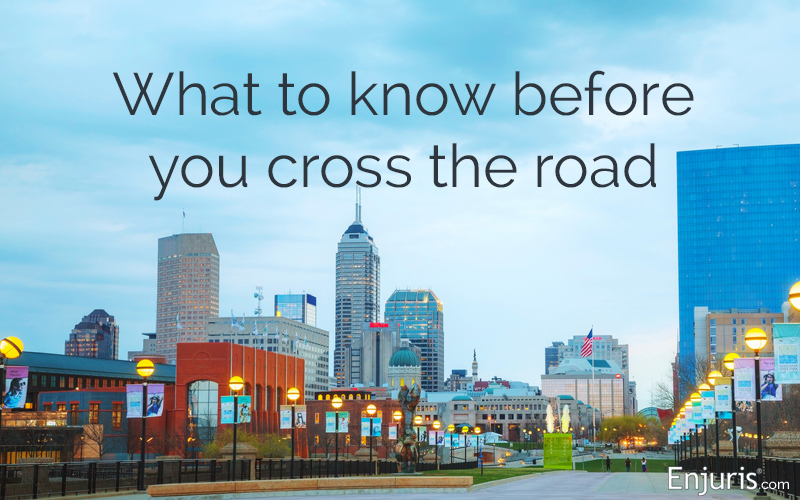Pedestrian laws, legal options, and safety tips in the Hoosier State
It’s a pleasantly warm evening in Bloomington, Indiana. After being stuck inside all day, Tom decides to walk to pick up some street food.
As Tom reaches the 4-way stop at Lincoln Street and East Kirkwood Avenue, he pauses for a moment and then, assuming he has the right of way, begins to cross the street. A Ferrari Enzo parked at one of the stop signs accelerates and crashes into Tom.
The impact of the crash fractures Tom’s leg, but he’s still conscious. He sits upright and watches the driver get out of the Ferrari and walk up to him with his finger pointed at the Ferrari. He’s yelling at Tom and claiming that Tom owes him money for the scratch on his hood.
Who had the right of way?
Does Tom owe the driver money for the damages to his hood, or can Tom recover damages from the driver for his injuries? What steps should Tom take?
Pedestrian accidents are a fact of life in every state. In this article, we’ll take a look at pedestrian accidents and the laws that impact pedestrians in Indiana.
Pedestrian injury statistics
Many cities in Indiana have become more walkable over the last decade. Unfortunately, this means pedestrian accidents have increased.
According to the Indiana University Public Policy Institute, there were 1,650 accidents involving pedestrians in 2018 (up 1.5% from 2017). Even worse, 114 pedestrians were killed in traffic accidents, making Indiana the 20th most dangerous state to take a walk.
Indiana pedestrian laws
All states have right-of-way laws that determine who has the right to proceed in certain situations. Traffic accidents often happen because the parties involved didn’t know who had the right of way.
When it comes to pedestrians, Indiana’s right-of-way laws are actually pretty simple:
Pedestrians have the right of way when crossing a marked crosswalk or an intersection. In all other situations, pedestrians must yield the right of way.
Remember the hypothetical scenario in the introduction to this article?
In the hypothetical, Tom the pedestrian had the right of way because he was crossing at an intersection.
There are other laws that impact pedestrians in Indiana as well. These laws can be found in Title 9 of the Indiana Code. Here are the highlights:
- Pedestrians have a duty to obey all traffic control devices unless otherwise directed by a police officer.
- Indiana does NOT have a state-wide law requiring pedestrians to cross only at crosswalks. However, such laws can be established by local ordinance.
- Pedestrians are prohibited from suddenly leaving the curb or other place of safety and walking or running into the path of a vehicle that’s too close to stop safely.
- If a vehicle is stopped at a crosswalk or intersection to permit a pedestrian to cross the road, a person driving behind the stopped vehicle can NOT overtake and pass the stopped vehicle.
- Pedestrians can NOT cross an intersection diagonally unless authorized by a traffic control device.
- If a sidewalk is available, pedestrians are prohibited from walking along an adjacent road.
- Pedestrians are NOT permitted to hitchhike.
- A person who drives a vehicle across a sidewalk must yield the right-of-way to a pedestrian.
Determining fault in an Indiana pedestrian accident
To receive compensation after a pedestrian accident, an injured pedestrian must prove that the driver was at fault by establishing the 3 elements of negligence:
- The driver owed the pedestrian a duty to exercise reasonable care (all drivers have a duty to obey all traffic laws and exercise reasonable care to avoid harming others while navigating the roads),
- The driver breached the duty to exercise reasonable care, and
- The driver’s negligence caused the pedestrian’s injury.
Of course, pedestrians also have a duty to obey all traffic laws and exercise reasonable care when navigating the roads. Accordingly, a driver can recover damages from a pedestrian by establishing that the pedestrian was negligent.
What happens if both the driver and the pedestrian are negligent?
Indiana is a modified comparative fault state. This means that the plaintiff’s damages are reduced by their percentage of fault. Moreover, if the plaintiff is more than 50% at fault for the accident, the plaintiff is barred from recovering any damages.
Let’s look at an example:
Jonathan is walking home and decides to cross the road despite not being at a crosswalk or an intersection. At the same time, Marissa is texting and driving. Because she’s looking down at her phone, she doesn’t see Jonathan and she crashes into him. Jonathan suffers damages in the amount of $100,000 and sues Marissa for negligence.
A jury determines that Marissa was 60% at fault for the accident (for texting while operating a vehicle) and Jonathan was 40% at fault for the accident (for failing to cross at a crosswalk or an intersection). Because Indiana is a modified comparative fault state, Jonathan’s damages will be reduced by his percentage of fault (i.e., he’ll only be able to recover $60,000).
In rare cases, the town or city may be at fault (or partially at fault) for the pedestrian accident.
For example, a town or city may be liable if a traffic control device failed or if the street was laid out poorly. Your personal injury attorney will consider all possible defendants and include everyone who may be liable in your lawsuit in order to increase your chances of recovery.
Damages available in an Indiana pedestrian injury lawsuit
Compensatory damages represent the money awarded to a plaintiff in a personal injury lawsuit. In Indiana, there are 2 main types of compensatory damages that an injured plaintiff can receive:
- Economic damages. Economic damages represent the monetary losses caused by an accident and include things like medical expenses, lost income, and property damage.
- Noneconomic damages. Noneconomic damages represent the non-monetary losses caused by an accident and include things like pain and suffering and emotional distress.
In addition to compensatory damages, plaintiffs may be entitled to punitive damages if the defendant’s conduct was intentional or malicious.
What to do after a pedestrian accident
The most successful personal injury lawsuits are often those in which the plaintiff takes the proper steps immediately after an accident. In the case of a pedestrian accident, injured pedestrians should do (and not do) the following:
Steps to take after a pedestrian accident
Seek medical attention. Your health should always be your top priority following any sort of accident. If you need medical assistance, call an ambulance or have someone at the scene call an ambulance for you. Even if you don’t think you suffered a serious injury, you should see a doctor as soon as possible. Certain injuries, including concussions and serious internal injuries, may not show symptoms for hours, days, or even weeks after an accident.
Call the police. In addition to getting medical attention, make sure the police are called to the scene of the accident. The police can conduct an investigation and draft a police report that may help support your insurance claim or lawsuit. Along these lines, be sure to make your voice heard. Tell the responding officer your side of the story so they can include it in the report.
Collect and preserve evidence. If you’re able to do so safely, take as many photographs of the scene as possible. The general rule is that more is better, so take photos of your injuries, any damage to the vehicle, traffic signals, license plates, road and weather conditions, and anything else you see.
Gather witness information. Are there witnesses at the scene of the accident? Other pedestrians? Other drivers? People in nearby buildings that may have seen the accident through the window? Gather the names, addresses, and telephone numbers of anyone who may have witnessed any part of the accident (whether it’s the actual accident, the events leading up to the accident, or the aftermath).
Don’t discuss the accident on social media. As soon as a defense attorney gets a new case, they review the plaintiff’s social media accounts for anything that may hurt them. Don’t bother trying to decide whether the information you post will help or hurt your case, assume it will hurt and avoid posting it.
Don’t accept a settlement too quickly. Following a pedestrian accident, the insurance company for the driver may contact you to try to get you to accept a settlement and sign a release. Initial settlement offers are often (though not always) too low. What’s more, it’s hard to know how much your claim is worth right after an accident. The best thing to do is to talk to an attorney before you accept an offer. At the very least, make sure you’ve seen a doctor so you know the full extent of your injuries.
Tips for staying safe as a pedestrian
The best kind of lawsuit is the one you never have to file. Indiana University has several tips for preventing a pedestrian accident:
- Make yourself visible (wear bright clothing, reflective clothing, headlamp, etc.)
- Walk on the sidewalk
- Cross only at marked crosswalks and intersections
- Look left, right, and left again before crossing
- Use pedestrian pushbuttons where possible and obey “walk” and “don’t walk” signals
- Make eye contact with drivers and never assume they see you
- Don’t use railroad tracks as a walkway
And some tips for drivers:
- Obey the posted speed limit
- Always watch for pedestrians, especially when turning at an intersection
- Remember that pedestrians have the right of way at a crosswalk and intersection
- Respect bike lanes
- Don’t pass a vehicle that’s stopped at a crosswalk
Injured in a pedestrian accident? An Indiana personal injury attorney can help. Find one in your area using our free online directory.
See our guide Choosing a personal injury attorney.


